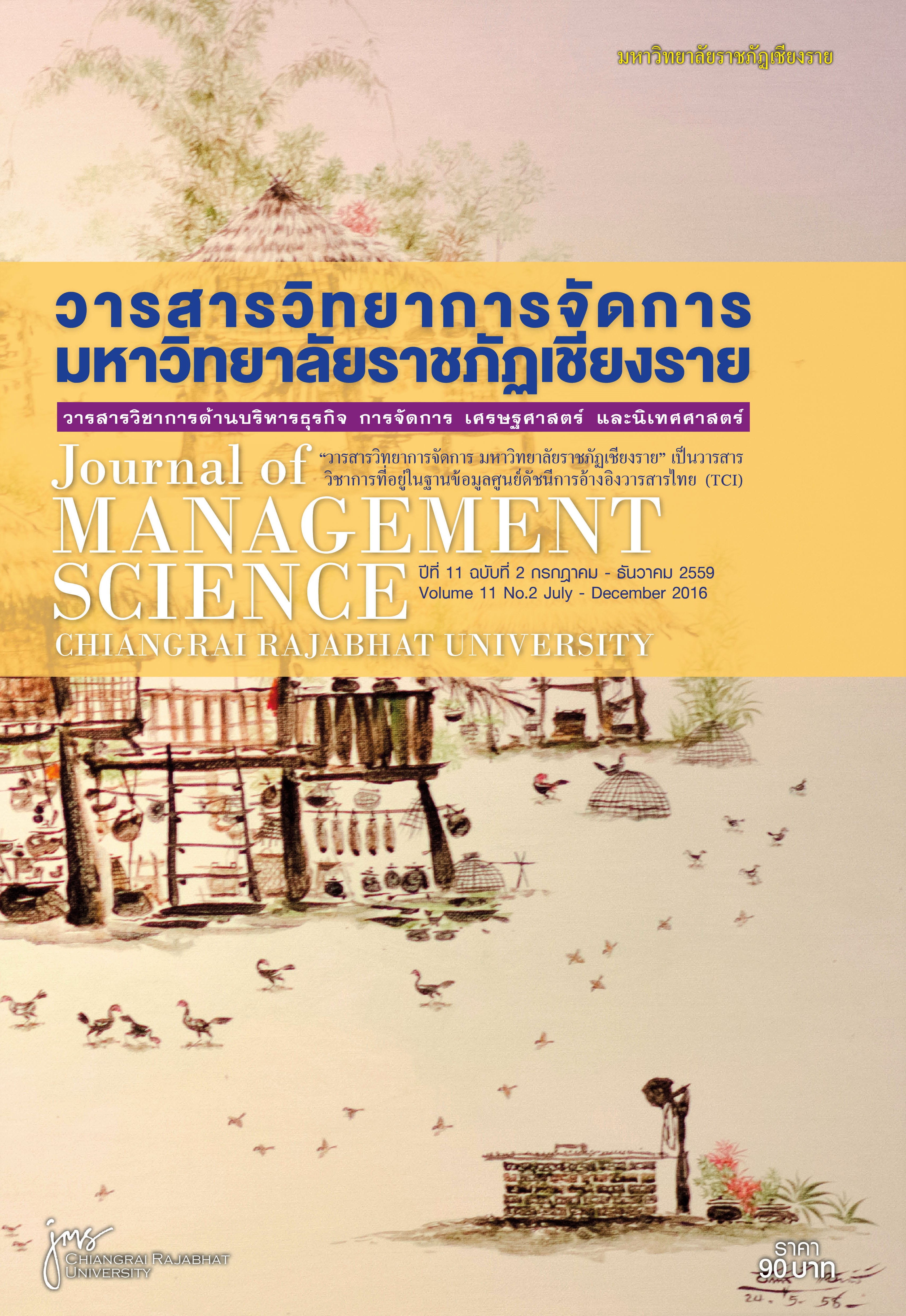ความสัมพันธ์ระหว่างการบริหารทรัพยากรมนุษย์กับความผูกพันต่อองค์การ ของพนักงานโรงแรมในเขตพื้นที่ภาคใต้ ประเทศไทย
Main Article Content
บทคัดย่อ
การศึกษาครั้งนี้มีวัตถุประสงค์เพื่อ ศึกษาความสัมพันธ์ระหว่างการบริหารทรัพยากรมนุษย์กับความผูกพันต่อองค์การของพนักงานโรงแรมในเขตพื้นที่ ภาคใต้ ประเทศไทย ซึ่งกลุ่มตัวอย่างที่ใช้ในการศึกษาคือพนักงานโรงแรมในเขตพื้นที่ภาคใต้ ประเทศไทย จำนวน 1,201 คน เครื่องมือที่ใช้ในการเก็บรวบรวมข้อมูลเป็นแบบสอบถาม ซึ่งมีความเชื่อมั่นด้านการบริหารทรัพยากรมนุษย์เท่ากับ 0.878 และความเชื่อมั่นด้านความผูกพันต่อองค์การเท่ากับ 0.811 สถิติที่ใช้ในการวิเคราะห์ข้อมูลได้แก่ ค่าร้อยละ ค่าเฉลี่ย ส่วนเบี่ยงเบนมาตรฐาน การวิเคราะห์องค์ประกอบเชิงยืนยันและการวิเคราะห์แบบจำลองสมการโครงสร้าง
ผลการศึกษาพบว่า พบว่า ค่าเฉลี่ยของมิติด้านต่าง ๆ ของการบริหารทรัพยากรมนุษย์ของพนักงานโรงแรมในเขตพื้นที่ภาคใต้ ประเทศไทย โดยเฉลี่ยทุกด้านอยู่ในเกณฑ์มาก ( = 3.82, S.D. = 0.76) ซึ่งมีค่าเฉลี่ยมิติด้านการจัดหาทรัพยากรมนุษย์มากที่สุด (
= 3.97, S.D. = 0.67) และค่าเฉลี่ยมิติด้านการพัฒนาทรัพยากรมนุษย์มีค่าเฉลี่ยน้อยกว่าค่าเฉลี่ยในมิติด้านอื่น ๆ ของการบริหารทรัพยากรมนุษย์ (
= 3.82, S.D. = 0.76) และค่าเฉลี่ยของมิติด้านต่าง ๆ ของความผูกพันต่อองค์การของพนักงานโรงแรมในเขตพื้นที่ภาคใต้ ประเทศไทย โดยเฉลี่ยทุกด้านอยู่ในเกณฑ์มา ( = 3.92, S.D. = 0.86) ซึ่งมีค่าเฉลี่ยมิติด้านความเชื่อมั่นและการยอมรับองค์การมากที่สุด ( = 4.02, S.D. = 0.69) และค่าเฉลี่ยมิติด้านการใช้ความพยายามเพื่อองค์การมีค่าเฉลี่ยน้อยกว่าค่าเฉลี่ยในมิติด้านอื่น ๆ ของความผูกพันต่อองค์การ ( = 3.81, S.D. = 0.72)
สำหรับแบบจำลองสมการโครงสร้าง พบว่า หลังปรับความสัมพันธ์แล้ว ค่าที่อยู่ในเกณฑ์ดีโดยมีค่าดังนี้คือ ค่าไคสแควร์ (X2) = 887.125, df = 123, RMSEA = 0.07 ช่วงความเชื่อมั่นร้อยละ 90 ของ RMSEA อยู่ในช่วง 0.068 ถึง 0.076, CFI = 0.95, RMR = 0.02 ซึ่งสามารถสรุปได้ว่าแบบจำลองสมการโครงสร้างการบริหารทรัพยากรมนุษย์หลังการปรับความสัมพันธ์ระหว่างค่าความคลาดเคลื่อนมีความสอดคล้องกับข้อมูลเชิงประจักษ์ในระดับดี และแบบจำลองแสดงถึงปัจจัยที่มีอิทธิพลโดยรวมต่อการบริหารทรัพยากรมนุษย์กับปัจจัยความผูกพันต่อองค์การ (อิทธิพลโดยรวม = 0.80)
Article Details
ทัศนะและข้อคิดเห็นของบทความที่ปรากฏในวารสารฉบับนี้เป็นของผู้เขียนแต่ละท่าน ไม่ถือว่าเป็นทัศนะและความรับผิดชอบของกองบรรณาธิการ
เอกสารอ้างอิง
ชาวประเสริฐ ชัยสมพล. (2546). การตลาดบริการ. กรุงเทพฯ : บริษัทซีเอ็ดยูเคชัน จำกัด (มหาชน)
Byrne, B.M. (2010). Structural equation modeling with AMOS: Basic concepts. Applications, and programming. New York, NY: Routledge.
Chi, C.G. & Gursoy, D. (2009). Employee satisfaction, customer satisfaction and Financial
performance: An empirical examination. International Journal of Hospitality Management, 28, 245-253
Creswell, J.W., & Clark, V.L.P. (2011) Designing and and Conducting Mixed Methods Research. (2 nd ed.) California.: SAGE Publications Inc.
Deloitte-Travel Tourism & Leisure. (2004). Focus on Thailand/Hotel industry continues to Attract interest/Deloitte Report. Retrieved December 17, 2006 from http://www.Hospitality Net-Industry New-Focus Thailand Hotel Industry Continues to Attract Interest Deloitte Report.htm
Dessler, G. (2006). Human Resource Management. 8th ed. New Jersey : Prentice-Hall.
Getz, D. & Pertersen, T. (2005). Growth and profit-oriented entrepreneurship among family
Business owners in the tourism industry. International Journal Hospitality Management, 24, 219-242.
Hair, et al., (2010). Multivariate data analysis: A global perspective. (7th edition). New Jersey, NJ: Pearson education Inc.
Kwok Leung, Peter B. Smith, Zhongming Wang and Haifa Sun. (1996). Job satisfaction in joint
venture hotels in chaina : An organizational justice analysis. Journal of International Business Studies; 1996, 27,5.
Ivancevich, John M. (2001). Human Resource Management. 8th ed. New York : McGraw-Hill.
Mowday, R.T., L.W.Porter, and R.M.Steers. (1982). Employee-Organization Linkages : The Psychology of Commitment, Absenteeism and Turnover. New York : Academic Press.
Mohinder Chand, (2007). The impact of HRM practices on organizational performance in the Indian hotel industry. Journal Employee relations vol.29 No.6, 2007.
Narumon Kimpakorn. (2007). Employees’ commitment to brands in the service sector: Luxury hotel chains in Thailand. Journal Brand Management Vol. 16,8,532-544.


